Education Links
Leaving Cert
 Maths
Maths
 French
French
 English
English
 Chemistry
Chemistry
 Physics
Physics
 Biology
Biology
 Economics
Economics
 Spanish
Spanish
 Geography
Geography
 History
History
Junior Cert
The rate of decay (activity) of a radioactive nuclide is directly proportional to the number of undecayed nuclei present in the sample.
1. Introduction
It is important to remember that a body must be forced to move in a circle.If you apply a force parallel to and in the same direction as the velocity of a body it will accelerate.
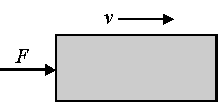
If you apply a force parallel to and in the opposite direction to the velocity of a body it will decelerate.
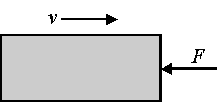
If you apply a force at RIGHT ANGLES to the velocity of a body it will move in a circle.
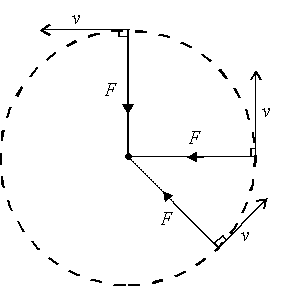
2. Characteristics of Uniform Circular Motion
When a body moves at a steady speed v in a circle of radius r not only is the distance travelled s changing but so is the angle q traced out in a certain time t leading to the idea of angular speed. Therefore it has a linear speed v as s changes and it has an angular speed w as q changes with time.Although it is moving at a steady speed it is not moving in a straight line and its direction is constantly changing. This means it is accelerating (centripetal acceleration) and so a force F (centripetal force) must exist.
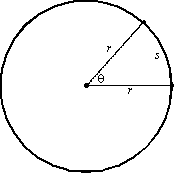
Notes:
(i) Velocity is a vector. It has size (speed) and direction. If either of these changes with time then the velocity is changing and so the body is accelerating.
(ii) An example of a body moving at a steady speed yet still accelerating is a body moving at a steady speed in a circle.
3. Definitions
(i) Angular Speed (w): The rate of change of angle (measured in radians).Unit: rad s-1
(ii) Centripetal Acceleration (a): For a body moving in a circle the centripetal acceleration is that acceleration acting at right angles to the velocity and towards the centre of the circle.
Unit: ms-2
(iii) Centripetal Force (F): The force acting at right angles to the velocity of a particle and towards the centre of a circle responsible for keeping it moving in a circle.
Unit: N (Newton)
(iv) Periodic Time (P): The time for the particle to complete one full revolution (orbit).
Unit: s (second)
(v) Frequency (f): The number of revolutions traced out in one second.
Unit: Hz = s-1
Note: An angle of 1 rad means an arc of length 1r (radius). Therefore an angular speed of w = 5 rad s-1 means the particle traces out an arc length (distance) of s = 5r in one second.
4. Equations of Circular Motion
(i) Relation between linear speed v and angular speed w: If the body goes from c to d in time t
If the body goes from c to d in time t 
(ii) Formulae for centripetal acceleration:
You need to know the following formulae:


Periodic Time P =

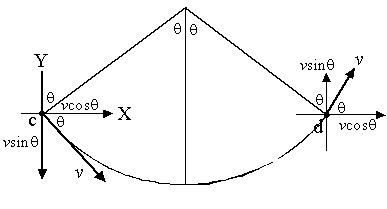
The x-component of velocity is the same at c and d and so the change in velocity and hence the acceleration is all in the y-direction.
Acceleration from c to d =

Now

Therefore acceleration from c to d =

As

Therefore the instantaneous acceleration is
 and acts in towards the centre of the circle.
and acts in towards the centre of the circle.Putting v = rw into
 gives
gives 
(iii) Formula for centripetal force
By Newton's second law of motion F = ma

(iv) Formulae for periodic time and frequency
Periodic time P =


Frequency = Number of orbits in one second

Notes:
(i) You must be able to derive (a) and (b).
(ii) Centripetal acceleration
 is on page 40 of the tables.
is on page 40 of the tables.(iii) To produce circular motion a centripetal force of magnitude
 (centripetal force) must be supplied. This can be done in many ways. In the examination this force will be tension, friction, normal reaction or gravity.
(centripetal force) must be supplied. This can be done in many ways. In the examination this force will be tension, friction, normal reaction or gravity.5. Problem Solving Technique
(i) Draw a snapshot of the particle moving in horizontal or vertical motion.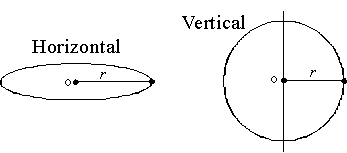
(ii) Put in all the forces (weight, normal reaction, friction, tension).
(iii) Apply: Net force in towards the centre of the circle is

(iv) Never use the equations of uniformly accelerated motion v = u + at etc., for circular motion problems.
(v) You can of course use the Principle of Conservation of Energy for motion in a vertical circle:
Note:
TME = Total mechanical energy
KE = Kinetic Energy
PE = Potential Energy
6. Problems
Example 1
Find the angular speed of a car which travels round a bend of radius 50 m with a speed of 30 kmhr-1.Solution
Example 2
A stone tied to a string is whirled around in a horizontal circle of radius 10 cm. If the mass of the stone is 20 g and the angular speed is 31.4 rad s-1 find the tension in the string.Solution
Example 3
A particle of mass 2 kg moves on a turntable which is rotating at an angular speed of 20 rad s-1. Find(i) the normal reaction between the particle and the turntable and
(ii) the co-efficient of friction. The radius of the circle is 50 cm. (g = 9.8 ms-1).
Solution
Example 4
A ball of mass 0.5 kg is struck so that it moves off with a speed of 10 ms-1 from c on the end of a string of length im which is fixed to a point o as shown. It describes a vertical circle. Using the Principle of the Conservation of Energy find its speed at the highest point d. Find also the tension in the string at c and the tension at d. (g = 9.8 ms-2)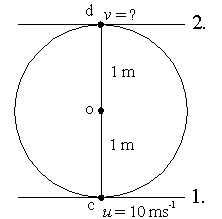
Solution


